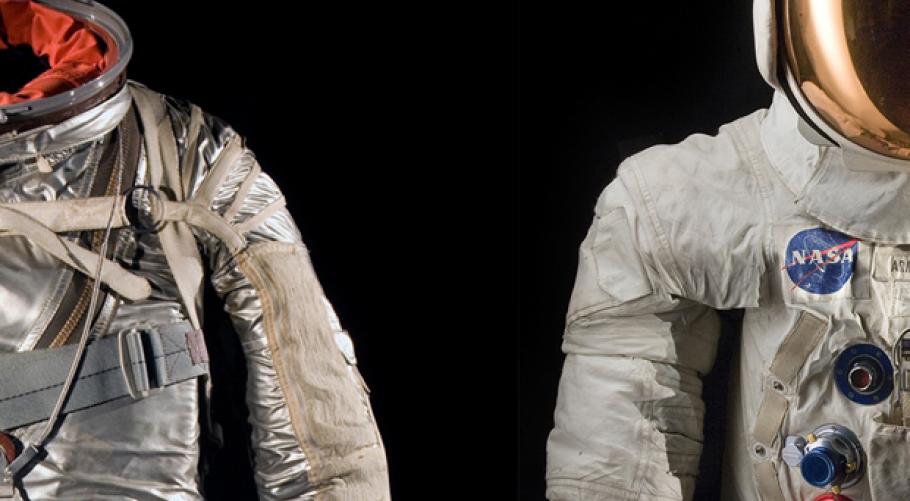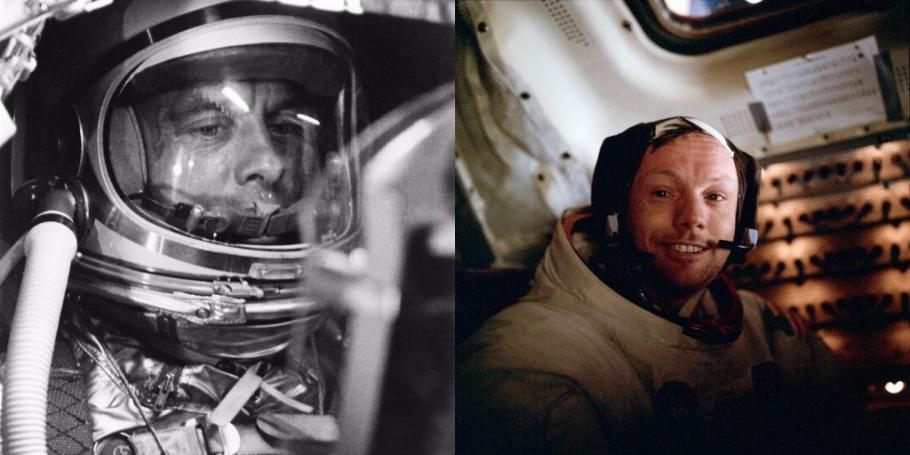We’ve received a few comments and questions about why our stretch goal for the Neil Armstrong #RebootTheSuit Kickstarter project is Alan Shepard’s Mercury Freedom 7 spacesuit. The short answer is that the two suits bracket the ideas and accomplishments of the Apollo space program. After the series of early Soviet firsts in space that included the first artificial satellite in space, the first animal in space, the first human (Yuri Gagarin) in space, and the first object to hit the Moon, President Kennedy went to his advisers to find out exactly what the United States could do to beat the Soviets once and for all.
The National Aeronautics and Space Administration (NASA) responded to the President’s request saying that given their existing knowledge and plans, and if they received adequate support, they could send a human being to the Moon by 1967. On May 5, 1961, Alan Shepard became the first American in space during a 15-minute, suborbital flight. Twenty days later, President Kennedy stood before a joint session of Congress, urging them to commit to a lunar program that would land humans on the Moon by the end of the decade as a part of a package of technological endeavors that would mark the U.S. as the world leader.
The differences between Alan Shepard’s spacesuit and Neil Armstrong’s spacesuit indicate amazing advancements in suit technology that occurred within just six short years. In that time, spacesuit engineers went from a modified flight suit that was originally designed to operate in the upper layers of our atmosphere to a suit that performed as a custom-fit spacecraft that allowed humans to explore another world. Shepard’s spacesuit was based on the U.S. Navy’s Mark IV flight suit that B.F. Goodrich had made. At the time, the Navy had focused on flight suits for fighter pilots who might experience high gravitational forces during flight maneuvers.
The suit was snug-fitting and would pressurize the lower body to avoid blood pooling in the pilot’s legs. The suit was adapted from its original cockpit design to one that would integrate into a spacecraft, the Mercury capsule. Engineers added additional buckles and pulleys to keep the suit in place for that one minute of microgravity that Shepard would experience during his flight. They added restraints to the shoulders so that the astronaut’s arms would not float uncontrolled while weightless. The gloves of the suit also feature fingertip flashlights so that the astronaut could focus a beam of light on any given point in the cockpit. Most obvious of all, a silver finish was applied to the Mark IV spacesuit to make it reflective and visible from a distance, less likely to absorb solar radiation beyond our atmosphere, and to distinguish it from other, more traditional, pilots’ flight suits.
In comparison, Shepard’s spacesuit and Armstrong’s spacesuit look very different. In many ways they are different, but the two also perform similar roles. Shepard’s suit was designed to operate inside a spacecraft and in the event of an emergency like depressurization, while Armstrong’s suit needed to perform as a personal, walking spacecraft. Armstrong’s suit incorporates all the features of the Shepard suit, but with added complexity. Like Shepard’s suit, Armstrong’s also had restraints that kept his arms from floating in weightlessness, but these were deeply embedded in the suit to both protect the restraints from the harsh atmosphere of space and to help prevent his suit from ballooning. Armstrong’s spacesuit also had an outer layer designed to reflect away solar radiation, but it was also designed to protect the astronaut from wide swings in temperature as well as be impenetrable to fast-moving space particles. And Armstrong’s suit was designed to function in not one, but three spacecraft: the Columbia command module, the Eagle lunar lander, and on its own with a personal life support system worn as a backpack on the surface of the Moon.
The Museum’s newest planned gallery, Destination Moon (scheduled to open in 2020), will present Alan Shepard’s Mercury spacesuit and Freedom 7 as artifacts of President Kennedy’s initiative to demonstrate that the United States was in fact more technically advanced than the USSR. Even though the country appeared to be months behind their Cold War competitor, the scientists, engineers, technicians, and politicians at the time had been confident that the country was capable of mobilizing for this challenge. Not only does the Shepard spacesuit illustrate that confidence, but it also represents the technological starting point at which the long-standing dreams of travelling to the Moon would become reality. In Destination Moon, and through these two spacesuits, the visitor will understand how the Moon race began and learn the way in which we went from Freedom 7 to Tranquility Base in just over eight years.
There are only seven days left to back the Museum’s #RebootTheSuit Kickstarter project. Help us tell the complete story of our journey to the Moon and consider becoming one of our more than 8,400 backers.



